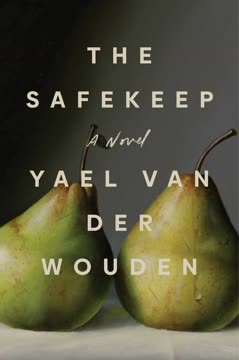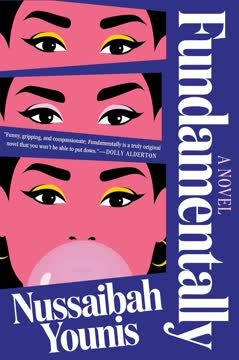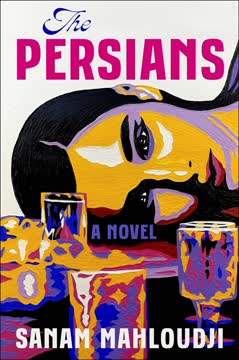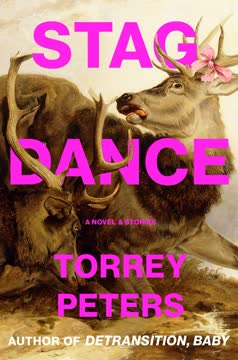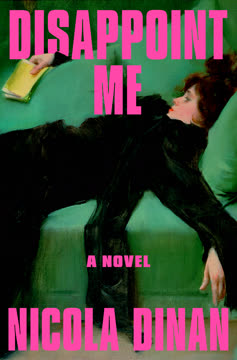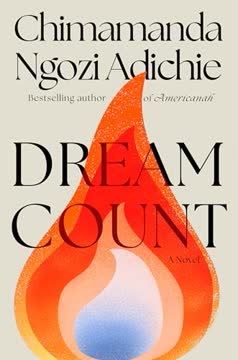Plot Summary
Return to Berlin Shadows
After years away at boarding school, Nila comes back to her family's cramped apartment in a low-income district of Berlin. The city is both familiar and alien, filled with the detritus of immigrant life and the ghosts of her Afghan family's past. Her mother is dead, her father is distant, and the apartment is haunted by memories and the weight of expectation. Nila's sense of displacement is immediate and overwhelming, and she seeks solace in the small rituals of home, even as she feels suffocated by its limitations. The city outside is alive with sirens, graffiti, and the relentless churn of poverty, setting the stage for Nila's restless search for meaning and escape.
Hunger for Ruin
Enrolling at university more for the perks than the education, Nila is drawn into Berlin's nightlife, seeking oblivion in clubs, drugs, and fleeting encounters. Her grief over her mother's death and her inability to meet her family's expectations drive her to the city's underbelly, where she finds a sense of belonging among other misfits. The hunger to ruin her life is both a rebellion and a coping mechanism, as she oscillates between the demands of her Afghan heritage and the seductive chaos of Berlin's party scene. The city's decay mirrors her own unraveling, and she is both repulsed by and addicted to its darkness.
The Bunker's Allure
The Bunker, a legendary Berlin techno club, becomes Nila's refuge from the pain of her daily life. Inside its dark, pulsating walls, she is anonymous, free to lose herself in music, drugs, and the company of strangers. The club is a microcosm of Berlin's contradictions—eclectic, permissive, and haunted by history. Here, Nila meets Marlowe Woods, an enigmatic American writer whose charisma and self-destructive tendencies mirror her own. Their connection is immediate and electric, setting off a chain of events that will define the trajectory of Nila's coming-of-age.
Marlowe's Spell
Marlowe is older, world-weary, and both alluring and cruel. He draws Nila into his orbit with a mix of tenderness and manipulation, offering her drugs, sex, and the illusion of artistic kinship. Their relationship is charged with power dynamics, secrecy, and the thrill of transgression. Nila lies about her origins, desperate to be seen as someone other than the poor Afghan girl from the ghetto. Marlowe, in turn, projects his own wounds onto her, and their intimacy becomes a battleground for desire, shame, and the longing to be remade. The boundaries between pleasure and pain blur, and Nila is both empowered and endangered by his attention.
Lies and Longing
Nila's life becomes a web of lies—to Marlowe, to her friends, to herself. She claims Greek or Spanish heritage, hides her family's poverty, and constructs a persona that is both armor and prison. Her longing for acceptance and love is matched by her fear of exposure. The lies are a survival strategy, but they also deepen her sense of alienation. As she navigates friendships, betrayals, and the shifting allegiances of Berlin's creative scene, Nila is haunted by the knowledge that her true self is always at risk of being found out—and rejected.
Family Ghosts
Nila's family history is one of displacement, loss, and thwarted ambition. Her parents, once doctors in Kabul, are reduced to menial jobs in Germany, their dreams stifled by bureaucracy and racism. Her mother's death leaves a void that Nila cannot fill, and her father's grief curdles into anger and control. The family's story is echoed in the lives of other immigrants in their building—each marked by trauma, resilience, and the struggle to belong. Nila's own ambitions—to be an artist, to escape—are both a tribute to and a rejection of her parents' sacrifices.
Becoming the Outsider
At boarding school, Nila is the scholarship girl, always on the margins of privilege. In Berlin, she is too foreign for the Germans, too Western for her Afghan relatives. Her friendships are fraught with envy, competition, and the ever-present threat of abandonment. Even in love, she is an outsider—never quite enough, always too much. The experience of being "other" shapes her identity, fueling both her creativity and her self-doubt. She learns to move between worlds, but never feels at home in any of them.
The Good Girl's Curse
The women in Nila's family are both enforcers and victims of patriarchal codes. To be a "good girl" is to be obedient, pure, and invisible; to break the rules is to risk ostracism or worse. Nila's mother, a complex figure of strength and neurosis, embodies these contradictions. Violence—both physical and emotional—is normalized, and love is often expressed through control or punishment. Nila's own sexuality is a site of conflict, desire, and guilt. Her attempts to claim agency are met with both internalized shame and external censure, and the legacy of "goodness" becomes a curse she must learn to break.
Doreen's Betrayal
Doreen, Marlowe's girlfriend, becomes both confidante and adversary. Their relationship is a dance of intimacy and competition, as they navigate the blurred lines between friendship and rivalry. When Nila confesses her affair with Marlowe, Doreen's reaction is a mix of cruelty and vulnerability, exposing the fragility of female alliances in a world shaped by male desire. The fallout from this betrayal forces Nila to confront the limits of her own empathy and the cost of her choices. The pain of losing Doreen is as acute as any romantic heartbreak, and it marks a turning point in Nila's journey toward self-knowledge.
The Truth Unravels
The lies that have sustained Nila begin to unravel. Her uncle discovers her secret life, and the truth about her relationship with Marlowe—and her Afghan identity—comes out. The fallout is swift and brutal: she is shamed, isolated, and forced to confront the consequences of her self-invention. Her family's disappointment is matched by her own sense of failure. Yet in the aftermath, there is a strange relief—a sense that, having been seen for who she truly is, she can finally begin to heal. The reckoning is both painful and necessary, a crucible through which Nila must pass to claim her own story.
Violence and Desire
The relationship with Marlowe grows increasingly toxic, marked by emotional manipulation, jealousy, and physical violence. The line between pleasure and harm is crossed, and Nila is forced to reckon with the reality of abuse. Her desire for Marlowe is inseparable from her need for validation, and the cycle of hurt becomes self-perpetuating. The violence is both literal and symbolic—a manifestation of the wounds carried by both lovers. In the end, Nila must choose between self-destruction and survival, between the comfort of the familiar and the possibility of something better.
The Festival of Escape
A trip to a utopian festival offers the illusion of escape—a world without police, hierarchy, or shame. But even here, the old dynamics persist: jealousy, betrayal, and the ever-present threat of violence. Nila's relationship with Marlowe reaches its breaking point, and she finds unexpected solace in the friendship of Eli, a fellow outsider. The festival becomes a crucible for transformation, as Nila confronts the limits of her own endurance and the necessity of letting go. The promise of freedom is tempered by the knowledge that true escape is never easy, and that the past is never far behind.
The Pink Panther Murders
A series of racially motivated murders—dubbed the "Kebab Mafia" killings—rock Berlin's immigrant communities. The violence is both random and targeted, a reminder of the precariousness of life for those deemed "other." The murders force Nila to confront the reality of racism in Germany, and the ways in which her own story is entangled with larger histories of exclusion and violence. The city's indifference is as chilling as the crimes themselves, and the sense of vulnerability is inescapable. The murders become a dark mirror for Nila's own struggles with identity, shame, and the longing for safety.
Aftermath and Reckoning
In the wake of violence—both personal and collective—Nila is forced to reckon with the losses that have shaped her life. The deaths of the Qurbani brothers, the end of her relationship with Marlowe, and the dissolution of old friendships leave her adrift but also newly open to possibility. She returns to her family, seeking reconciliation and understanding. The process is fraught, but there are moments of grace: a shared meal, a story about her name, a glimpse of her father's vulnerability. The reckoning is ongoing, but it is also a beginning.
Naming the Water
Nila learns the story behind her name—Nilab, after the river in Kabul that empties into the Indus. The act of naming becomes a way of claiming both her Afghan heritage and her right to self-definition. The river is a symbol of continuity and change, of the possibility of movement and renewal. In embracing her name, Nila begins to reconcile the disparate parts of her identity—the exile and the artist, the daughter and the rebel. The act of naming is both an ending and a beginning, a way of making peace with the past while looking toward the future.
Leaving Berlin
With the help of friends and her own determination, Nila secures a place at an art college in London. The move is both a literal and symbolic escape—a chance to start anew, to pursue her dreams, and to leave behind the ghosts of Berlin. The process is bittersweet, marked by farewells, nostalgia, and the anxiety of the unknown. Yet there is also hope: the promise of new friendships, new art, and the possibility of becoming the person she has always wanted to be. The city recedes, but its lessons remain.
The Weight of Memory
In her final days in Berlin, Nila turns to photography as a way of making sense of her experiences. She develops old rolls of film, finding in the images a record of love, loss, and survival. The act of looking—at herself, at her family, at the city—becomes a form of healing, a way of bearing witness to the complexity of her life. The book ends with a meditation on the power of art to transform pain into meaning, and on the necessity of remembering, even when it hurts. Nila's story is both singular and universal—a testament to the resilience of those who refuse to be defined by the wounds of the past.
Characters
Nila Haddadi
Nila is the novel's narrator and protagonist, a young woman caught between worlds—Afghan and German, immigrant and native, daughter and rebel. Marked by the trauma of exile, her mother's death, and the weight of family expectations, Nila is fiercely intelligent, self-destructive, and hungry for experience. Her relationships—with her family, with Marlowe, with her friends—are shaped by longing, shame, and the desire to be seen. Nila's journey is one of self-invention and self-discovery, as she navigates the dangers and possibilities of Berlin's underworld, the complexities of love and violence, and the challenge of claiming her own story. Her development is marked by moments of reckoning, vulnerability, and, ultimately, a hard-won sense of agency.
Marlowe Woods
Marlowe is an American writer living in Berlin, older than Nila and both her lover and her undoing. He is magnetic, intelligent, and deeply wounded, carrying the scars of his own family's tragedies and artistic disappointments. Marlowe's relationship with Nila is a crucible of desire, cruelty, and mutual need; he offers her both escape and danger, tenderness and violence. His charm masks a profound insecurity and a tendency toward manipulation and self-destruction. Over the course of the novel, Marlowe's power wanes as his failures accumulate, and his inability to truly connect or change becomes clear. He is both a catalyst for Nila's transformation and a cautionary figure—a reminder of the costs of refusing to heal.
Doreen Hübner
Doreen is Marlowe's girlfriend and, at times, Nila's friend and adversary. She is sharp, political, and emotionally volatile, embodying both the possibilities and the perils of female friendship in a patriarchal world. Doreen's relationship with Nila is marked by intimacy, competition, and betrayal; they are drawn together by shared experiences of marginalization and desire, but ultimately divided by Marlowe's duplicity and their own insecurities. Doreen's journey is one of survival and self-assertion, as she navigates heartbreak, new love, and the challenge of forging solidarity in a world that pits women against each other.
Elias (Eli) Zeneli
Eli is Nila's oldest friend, a fellow outsider whose family fled Kosovo during the war. He is gentle, introspective, and quietly supportive, offering Nila a rare sense of acceptance and understanding. Their relationship is marked by unspoken affection, shared trauma, and the comfort of being seen. Eli's own struggles—with identity, belonging, and the legacy of violence—mirror Nila's, and their friendship is a lifeline in a world that often feels hostile and indifferent. Eli's development is subtle but profound, as he moves toward stability, love, and a sense of purpose.
Anahita (Nila's Mother)
Anahita is a powerful absence in Nila's life—a beautiful, ambitious, and neurotic woman whose death leaves a void that shapes her daughter's every choice. Her story is one of exile, loss, and thwarted dreams; once a doctor in Kabul, she is reduced to menial work in Germany, her talents and hopes stifled by circumstance. Anahita's love is both fierce and fraught, expressed through control, violence, and moments of tenderness. Her memory haunts Nila, fueling both her rebellion and her yearning for connection. The mother-daughter bond is the novel's emotional core, a source of both anguish and inspiration.
Karim (Nila's Father)
Karim is a sensitive, artistic man undone by exile, grief, and the loss of his wife. Once a doctor, he is now a taxi driver, his ambitions and dignity eroded by poverty and disappointment. His love for Nila is expressed through control, anger, and moments of vulnerability. The relationship is marked by violence, misunderstanding, and a deep, unspoken bond. Karim's journey is one of slow decline, but also of moments of grace and reconciliation, as he and Nila struggle to find common ground in the aftermath of loss.
Sabrina (Nila's Aunt)
Sabrina is Nila's aunt and a model of resilience and ambition. Having rebuilt her career as a doctor in Germany, she embodies both the possibilities and the costs of adaptation. Sabrina is both supportive and critical, offering Nila guidance, tough love, and a perspective on the family's history that is both sobering and compassionate. Her own struggles—with motherhood, marriage, and the legacy of trauma—echo Nila's, and her presence is a reminder of the complexity of survival in exile.
Romy and Anna
Romy and Anna are Nila's childhood friends, representing the stability, privilege, and normalcy that often elude her. Their friendship is marked by moments of warmth, jealousy, and distance, as Nila's secrets and self-destructive tendencies create rifts. They offer her both support and a mirror for her own alienation, and their eventual stability and maturity highlight the costs and rewards of different paths. Their presence in Nila's life is both a comfort and a challenge, forcing her to confront what she wants and what she fears.
Setareh
Setareh is a Persian girl Nila meets during a formative summer, and their brief, secret romance is a touchstone for Nila's understanding of love, desire, and the limits imposed by culture and shame. Setareh is confident, artistic, and elusive, embodying both the promise of intimacy and the inevitability of heartbreak. Her departure marks a turning point in Nila's life, and her memory lingers as a symbol of what might have been.
The Qurbani Brothers
The Qurbani brothers run the neighborhood bakery and are both familiar figures and tragic casualties of the novel's central act of violence. Their deaths in a racially motivated attack underscore the precariousness of immigrant life in Germany and the ever-present threat of hatred and exclusion. Their story is woven into Nila's own, a reminder of the interconnectedness of personal and collective histories.
Plot Devices
Nonlinear Narrative and Memory
The novel employs a nonlinear structure, moving fluidly between past and present, memory and immediacy. This fragmentation reflects Nila's own sense of dislocation and the difficulty of constructing a coherent self in the aftermath of trauma and exile. Flashbacks to childhood, family history, and formative relationships are interwoven with scenes of Berlin's nightlife and the unfolding present, creating a tapestry of experience that is both intimate and expansive. The use of memory as a plot device allows for a deep exploration of the ways in which the past shapes, haunts, and sometimes liberates the present.
The Club as Liminal Space
The Bunker and other Berlin clubs function as liminal spaces—sites of transformation, danger, and possibility. Within their walls, social hierarchies are suspended, identities are fluid, and the boundaries between pleasure and pain, self and other, are blurred. The club is both sanctuary and trap, offering Nila a reprieve from the constraints of her family and culture, but also exposing her to new forms of risk and exploitation. The cyclical return to the club mirrors the cycles of addiction, desire, and self-destruction that define Nila's journey.
Lies, Masks, and Self-Invention
The motif of lying—about heritage, class, desire—runs throughout the novel, highlighting the ways in which identity is both constructed and imposed. Nila's shifting personas are both a means of survival and a source of alienation, reflecting the pressures faced by those who exist at the margins. The tension between authenticity and performance is explored through relationships, art, and the act of storytelling itself. The eventual unraveling of these lies is both a crisis and a liberation, forcing Nila to confront the costs and possibilities of truth.
Violence and Intimacy
The novel explores the complex interplay between violence and intimacy, both within families and romantic relationships. Physical and emotional harm are normalized, justified, and sometimes eroticized, reflecting the ways in which trauma is inherited and perpetuated. The line between love and abuse is often blurred, and the characters' struggles to break these cycles are central to the narrative's emotional arc. The depiction of violence is unflinching but nuanced, inviting readers to consider the ways in which harm and healing are entangled.
Art and Witness
Nila's passion for photography is both a plot device and a metaphor for the act of bearing witness. Through the lens, she seeks to capture, understand, and transform the pain of her experiences. The act of making art becomes a way of reclaiming agency, asserting presence, and forging connection. The novel's structure itself mimics the process of developing a photograph—bringing hidden images to light, finding meaning in fragments, and creating something lasting from the ephemeral.
Political Violence and Social Critique
The Pink Panther murders and the rise of neo-Nazi violence in Germany are woven into the fabric of the novel, grounding Nila's personal struggles in a broader context of racism, exclusion, and historical trauma. The interplay between individual and collective experience is a central theme, as the characters' lives are shaped by forces beyond their control. The novel critiques both the failures of the German state and the limitations of multiculturalism, offering a nuanced exploration of what it means to belong—and to be denied belonging.
Analysis
Aria Aber's Good Girl is a searing, polyphonic meditation on exile, identity, and the search for belonging in a world marked by violence and displacement. Through Nila's journey, the novel interrogates the costs of assimilation, the wounds of inherited trauma, and the seductive dangers of self-invention. Berlin is rendered as both a site of possibility and a crucible of loss—a city where the ghosts of history are ever-present, and where the promise of freedom is always shadowed by the threat of exclusion. The novel's nonlinear structure, lyrical prose, and unflinching honesty invite readers to inhabit the fractured consciousness of its protagonist, experiencing the world as she does: with hunger, fear, and a relentless drive to make meaning from chaos. At its core, Good Girl is about the power of art to bear witness, to transform pain into beauty, and to assert the dignity of those who refuse to be defined by the wounds of the past. It is a story of survival, of the necessity of naming and claiming one's own story, and of the hope that, even in the aftermath of violence, something new and true can be born.
Last updated:
Review Summary
Good Girl receives mixed reviews, with praise for its poetic prose and exploration of identity, shame, and displacement. Critics appreciate the vivid depiction of Berlin's club scene and the nuanced portrayal of Nila's struggles as an Afghan immigrant. However, some find the narrative repetitive and the characters underdeveloped. The toxic relationship and drug use themes divide readers. Despite flaws, many reviewers consider it a compelling debut that tackles complex themes of cultural identity and belonging in post-9/11 Germany.
Similar Books
Download PDF
Download EPUB
.epub digital book format is ideal for reading ebooks on phones, tablets, and e-readers.

